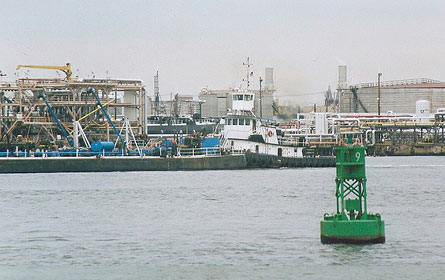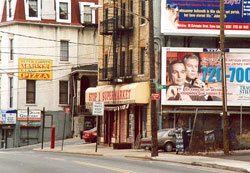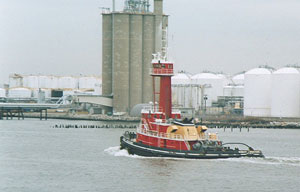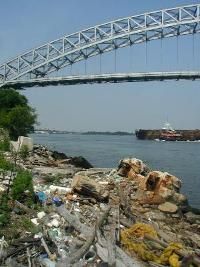A week after we posted this article, Melissa Checker learned of another perhaps even mrore serious toxic threat on Staten Island. A former warehouse on the North Shore played a significant part in the Manhattan Project, leaving behind levels of uranium contamination nearly 10 times higher than allowable standards in some places. Read her Wonkster post on this development.
This spring, residents of Staten Island's North Shore received news of a triple toxic whammy. First, on March 23, 300 gallons of oil spilled during a ship-to-ship transfer near the St. George ferry terminal. Then, on April 2, the federal Environmental Protection Agency announced that it found lead levels up to 10 times higher than acceptable on the site of a former Sedutto's ice cream factory, just steps away from several homes. That same night, the agency stated that it found elevated levels of lead and arsenic at nearby Veterans Park.
These events mark only the tip of a highly toxic iceberg threatening Staten Island's North Shore. An area of approximately 5.2 square miles, the North Shore contains approximately 21 sites that the Environmental Protection Agency or residents have identified as contaminated. All of them sit within 70 feet of homes and apartment buildings, and residents believe that many violate state environmental regulations. For Beryl Thurman, president of the North Shore Waterfront Conservancy, the industrial zone free-for-all "is like a Girls Gone Wild video."
Yet, the North Shore's toxic woes remain a dirty New York City secret. While Staten Island's most famous waste site, Fresh Kills, once the world's largest landfill, has received abundant attention in recent years, the media has largely ignored Staten Island's other toxic sites. North Shore residents find that they must fight to have their voices heard by state and local officials. Thurman believes it comes down to demographics. The North Shore has the borough's lowest household income, and 48 percent of its households are black or Hispanic. We are "a low-income community of color... If Staten Island is the 'forgotten borough' then on the food chain, we're way down low," Thurman said.
A visit to the North Shore dramatically illustrates the area's uneasy mix of residences and industry. A public pool perched on a hill above the harbor offers a view of garbage-loaded barges. Just west of the pool, an enormous mound of road salt housed at the nearby Atlantic Salt Co. rises high into the sky. Streets feature rows of 19th century shotgun houses side-by-side with notoriously noxious neighbors like a city Department of Sanitation garage, an auto demolition company and a waste transfer station, to name a few.
Residents also fear the specter of past industries. Before it was Sedutto's, the ice cream factory site housed a succession of lead companies. Other former facilities produced gypsum, railway freight cars, boats, ships and linseed oil. The remnants of the chemicals used haunt North Shore residents, who fear that the substances might leach into groundwater and circulate through the air, threatening public health.
They have reason to worry. According to the American Lung Association, Staten Island has the worst smog of any of the five boroughs, and the New York State Department of Health reports that the death rate from lung cancer on Staten Island is 48 percent higher than for the rest of New York City. Thurman herself was diagnosed with asthma in her early 40s. "It wasn't something that was in my family or that I had as a kid," she remembered. According to Thurman, many North Shore residents have developed rare forms of cancer.
Residents hope that remediation of the Sedutto's site will spur a larger effort to give all of the North Shore's toxic areas the attention they deserve. "A lead contaminated site in a residential area would not be tolerated in Brooklyn or Manhattan," said U.S. Rep. Michael McMahon, who represents the area. "We have a number of potentially toxic sites on Staten Island, and it is time to remediate them."
A Toxic Legacy
In stark contrast to its present state, until the late 1800s, Staten Island's North Shore served as a resort area for New York's hoi polloi. However, as the industrial revolution overtook New York, Staten Island's waterways became integral to the city's growing economy, and industries proliferated along the North Shore. By the turn of the 20th century, the area had become Staten Island's most densely populated in terms of industry and people.
It was not until the passing of zoning laws in 1961 that the city undertook a serious effort to limit the degree to which industries and residences could cohabitate. At that time, the city zoned almost half of Staten Island's waterfront, including all of the North Shore, for industrial use. New residences had to have buffers to protect them from certain kinds of industries, but the city permitted all existing industrial properties and residences to remain as they were.
Today, that mix continues. At present, the North Shore houses two private waste transfer stations, an abundance of salvage yards, a Department of Sanitation garage, a Con Edison plant, an Metropolitan Transportation Authority bus depot, a private luxury coach depot and a New York City Department of Environmental Protection sewer treatment plant. Many of these facilities have replaced older and even more noxious industries, but some require the use of oversized trucks, which frequently travel on local streets. That truck traffic contributes to the borough's overall poor air quality.
Hazardous Waters?
Bordering all of these sites is the tidal strait known as the Kill Van Kull. Every year, hundreds of cargo ships and tankers pass through the kull, which is zoned for industrial use. Fuel lines connecting New York and New Jersey run under the water. Some experts estimate that over 300 oil spills occur in the kull every year from the fuel lines and from ship transfers like the one in March. While the Coast Guard was able to clean up most of the March spill, the guard also has promised to step up its enforcement on spills in the Kill Van Kull, as well as illegal dumping.
Under New York law, waterfront industries must comply with the State Pollutant Discharge Elimination System to control discharges into waterways and groundwater. Local environmentalists, such as Jim Scarcella of the Natural Resources Protective Association, worry that because the regulation relies on factories and other sources to report any discharges themselves, facilities along the kull "might not be in compliance."
Portions of the Kill Van Kull are part of the Diamond Alkali Superfund Site, which includes the lower Passaic River and parts of the Newark Bay. According to the Environmental Protection Agency, these bodies of water contain dioxin, PCBs, mercury, DDT, pesticides and heavy metals from various companies that once manufactured pesticides -- including those used to make Agent Orange -- along the Newark Shore.
Local environmentalists fear the situation could get worse. Ongoing dredging by the Army Corps of Engineers and private waterfront industries could unearth those contaminants. In 2005, the Natural Resources Defense Council, NY/NJ Baykeeper and GreenFaith filed a successful lawsuit to stop the Army Corps of Engineers from dredging the kull. In a settlement, the Corps of Engineers agreed to adopt stricter environmental safety measures. Today, however, dredging continues near the Bayonne Bridge, adding noise to North Shore residents' long lists of pollution complaints.
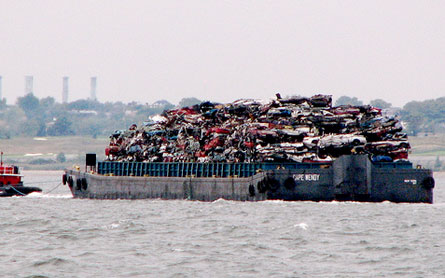
For obvious reasons, the New York State Department of Health distributes fishing advisories throughout the North Shore warning people not to eat locally caught fish. Yet, subsistence fishing continues. For years, the North Shore Waterfront Conservancy has requested that either the Department of Environmental Conservation or the state health department place hazard signs at popular fishing areas, to no avail. "It's about liability and jurisdiction," Thurman suspects.
A Bittersweet Victory
The Sedutto's site represents a prime example of the North Shore's combination of past and present toxic threats. Its history with lead production made it a candidate for the federal Superfund program, which was enacted to clean up toxic sites. However, according to an Environmental Protection Agency spokesperson, the government team sent to inspect the area in the early 1980s had an incorrect address. Unable to find the property, the agency closed the case.
For the next two decades, Sedutto's sold and re-bought the site several times. By the late 1990s, the ice cream plant was no longer operating and the property sat vacant until Perfetto Construction purchased it in 2007. Last April Thurman noticed that Perfetto was using the site to store equipment and debris from a nearby sewer construction project.
"There's all this dust and dirt flying around on everything. So, I'm on the phone with the [New York State Department of Environmental Conservation] and the EPA going, 'what are you doing to protect the residents whose homes are right here?'" she said. Thurman also contacted her then City Council member, McMahon. Eventually, her efforts paid off -- the Department of Environmental Conservation issued a stop work order, and McMahon helped pressure the federal Environmental Protection Agency to re-open its investigation. The agency then discovered the elevated lead levels.
Upon making its April 2 announcement, the Environmental Protection Agency began initial remediation. The agency asked Perfetto to install silt fencing and hay bales around the site's perimeter to prevent migration of the lead, and is "evaluating further steps to be taken," according to a government spokesperson. Meanwhile, McMahon's office has coordinated with the Community Health Center of Richmond and the Beacon Christian Community Health Center to offer free lead testing to area residents.
The lead and arsenic contamination over at Veterans Park is unrelated to the Sedutto's site, according to an Environmental Protection Agency spokesperson. Rather, the agency traces the toxins there to the past use of pesticides by the Parks Department. Officials also maintain that contaminant levels are relatively insignificant -- lead is considered hazardous at 400 parts per million and was found at 516 parts per million one foot below the surface of the park. The hazardous threshold for arsenic is 16 parts per million. At Veterans Park, levels were discovered at 1.4 to 81.5 parts per million.
To protect park users, the agency has covered the ground with woodchips to contain any toxins that might surface. But community members continue to worry about the safety of the park, which remains under the jurisdiction of the city Department of Parks and Recreation. Local families use the park, mainly a grassy field, for picnicking, playing soccer, mini football and baseball games. As Thurman points out, "kids are throwing [the] mulch in each other's faces."
Community groups including North Shore Waterfront Conservancy and the Port Richmond Improvement Association and the local business organization, the Port Richmond Board of Trade, want the city to close the park and complete further remediation.
Since the April meeting, they also have asked the department to post warning signs around the park to no avail. In early May, residents took matters into their own hands and placed two 4-by-8 foot bilingual signs at the park. A few days later, the parks department removed them. "While we understand the community's concern, we cannot allow unauthorized signs on parks property," spokeswoman Meghan Lalor told the Staten Island Advance.
Other community requests for action have met with less dramatic but similarly limited results. For instance, residents asked to relocate two transit authority bus stops near the former Sedutto's site and requested more prominent signs warning of possible hazards there. They also want the Environmental Protection Agency to test nearby Faber Park for contamination.
Local Actions
Since its inception in 2001, the North Shore Waterfront Conservancy has been a persistent voice for environmental justice on the North Shore. For instance, in addition to campaigning to get the former Sedutto's site tested, Thurman, who recently won a 2009 EPA Environmental Quality Award for Individual Citizens, repeatedly calls the state Department of Environmental Protection to complain that the sewer treatment plant "stinks to high heaven" and needs a major upgrade.
The conservancy also sponsors ecotours and regular garbage cleanups of public spaces along the waterfront in order to educate community members about environmental and health issues. In another ongoing project, the groups are gathering a database of potentially contaminated sites that details their present and former uses, the chemicals involved in those uses and the health risks they present. Finally, it advocates for sustainable economic development along the waterfront, which would ensure existing businesses reduce emissions and bring in new, environmentally friendly business.
The last objective is shared by the Staten Island Economic Development Corp., which recently launched an effort to establish a Green Enterprise Trade Zone on Staten Island. The zone idea dovetails with many initiatives in Mayor Michael Bloomberg's PlaNYC 2030.
The North Shore Waterfront Conservancy supports such plans as long as they don't lead to gentrification and the displacement of North Shore residents, according to Thurman. She has reason to be wary -- the development corporation, along with City Councilmember James Oddo's office, held a "Staten Island Health and Environmental 2009" conference in September. They invited representatives from green-tech industries but neglected to reach out to conservancy or other local environmental groups.
For now, though, North Shore residents have focused their attention primarily on the more immediate future of the former Sedutto's site and Veterans Park. The Environmental Protection Agency plans to hold a public meeting in early June to discuss lead threats in the community. Meanwhile, North Shore residents and their advocates continue to pressure the agency, as well as its state and local counterparts, to clean up their acts.
"The general thing is to make the waterfront and the waterfront communities safe," states Thurman, "The way people are treated in those communities right now it's like because... you are in a certain income status, it's your lot in life that you suffer."
Melissa Checker is assistant professor of urban studies at Queens College, City University of New York. She is the author of Polluted Promises: Environmental Racism and the Search for Justice in a Southern Town.
